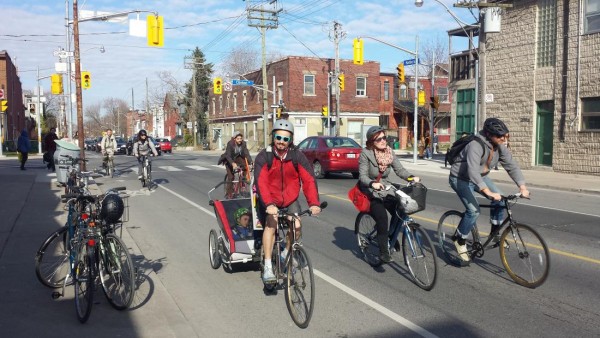The City of Toronto was awarded a Silver Bicycle Friendly Community Award in 2012 for achievement in the areas of Education, Enforcement, Engineering, Education and Evaluation. In April 2015, the City was awarded Gold for progress made over the last 3 years. Share The Road makes these awards based on the League of American Bicyclists Awards program:http://bikeleague.org/community
Jared Kolb, Executive Director of Cycle Toronto, wrote members this letter in response.
I love riding my bike in Toronto. In fact, I love it so much I spend my working life advocating for safer streets. But today, Toronto was awarded a Gold Bicycle Friendly Community Designation at the Ontario Bike Summit. I want to tell you about why I wasn’t there to celebrate it with them.
When I think of gold, I think of a place that younger people and older adults would ride with ease. Yet what I hear most from Torontonians is that they’re by and large too afraid to ride. For every safe cycling street like Harbord there are 10 Steeles and Morningsides. We need a city-wide minimum grid of protected lanes and bicycle boulevards to invite all Torontonians to ride.
When I think of gold, I think of a place with few collisions. Yet in Toronto in 2012, there were 1,475 cyclists struck by cars. That’s one every 6 hours every day of the year. In 2013, 4 people were killed while riding their bikes. We shouldn’t have to take our lives in our hands when we ride.
When I think of gold, I think of huge numbers of people traveling by bicycle for everyday trips. While a few neighbourhoods in the downtown boast impressive mode share as high as 20%, city-wide, only 2% of people ride regularly. 55% of all trips Torontonians make are less than 7 km, which takes the average person about 30 minutes to ride. But we need leadership from City Council to cultivate cycling’s city-wide potential.
When I think of gold, I think of significant investments in mass cycling. We spend more than $6,000 per person per year in Canada on health care, yet in Toronto, we spend only $3.08 per capita on cycling infrastructure. Ottawa spends more than $8 per person on cycling. Doubling cycling’s budget is long overdue.
Toronto is fortunate to have an ever-more talented group of staff implementing bicycle infrastructure at the City. Cycling events and programs across the city are fantastic. And I’m encouraged by the City’s recent move to pilot protected bike lanes on Richmond and Adelaide and extend them east to Parliament this summer.
The momentum is shifting. We should use the gold award not as a goal that’s been achieved, but as a rallying point to drive our work forward. We need to demand more from our elected officials. 73% of Torontonians say they want to ride more but that on-street safety is holding them back. We know cycling is the best way to get around town and we need to rally together and demand better infrastructure. Over the coming months we’re going to ask you to take action to build safer streets for all and create a more people friendly Toronto.
There’s a reason why cyclists are the happiest commuters. Riding a bicycle is awesome. Take a ride along Harbord and you can’t help but feel inspired. People who ride bicycles in Toronto have hearts of gold. Let’s use this moment to do better as a city and invest more in cycling to truly unlock its potential.
Ride Safely,
Jared Kolb
Executive Director


5 comments
The link to the League criteria PDF is wrong. It currently points to somewhere on the UofT site.
Thanks Joe. We’ve fixed it.
I’m skeptical on the need to encourage cycling. For instance, I was traveling east on Bloor West near High Park yesterday. There was one cyclist on the right lane. All the cars had to either wait behind him or change to the left. i.e. One person significantly slowed the traffic for a hundred people in few dozen cars. Is it really worth it? (Any stats?)
The shops in that area are quite dead, half of them are closed down. Moving more people should increase businesses, regardless of mode of transportation. I’m more for public transportation.
Yes, riding feels awesome. But policy is about best interest of most people. Besides, cycling has the #2 highest rate of injury of all sports. The health care saving is thus moot.
@adora: source for the stat in the final paragraph? Also, source for the rate of injuries that result in an interaction with the Health Care system, and the average costs of such interaction (to support the conclusion in your last sentence).
Sounds like a good paper topic.
@caio http://www.scientificpsychic.com/fitness/injuries.jpg is just the first one I pull off google. Their number is for emergency room treated injury by sports. No number in costs by sports. It would be interesting.
I have also heard on Science Friday or BBC Health Check that cycling is one of the sports with highest rate of head trauma and concussion mainly due to noncompliance in headgear usage. Afterall, you don’t need a license to bike and no one ever gets ticketed for not wearing helmets. They degree of head trauma might not be as severe as in contact sports, but definitely more prevalence. i.e. The more popular cycling is, the higher number of casual riders, the lower headgear compliance, and thus higher rate of injuries.
This is why I’m very skeptical. If the goal is truly “health”, can’t we just walk?